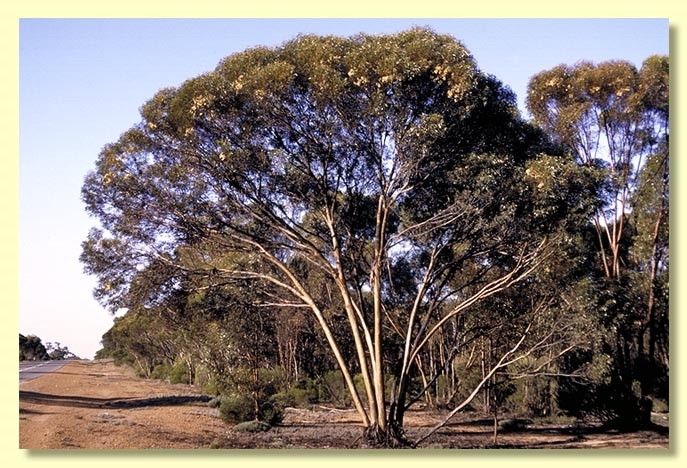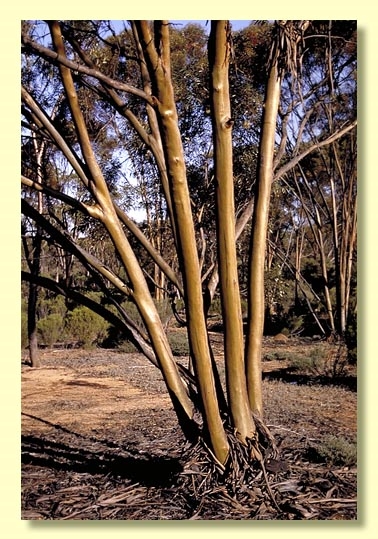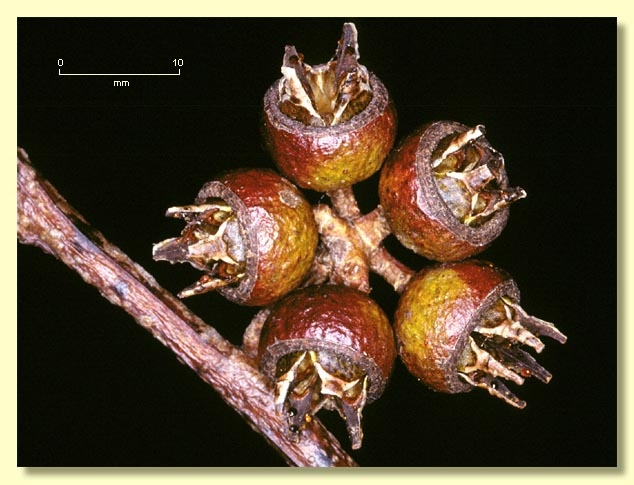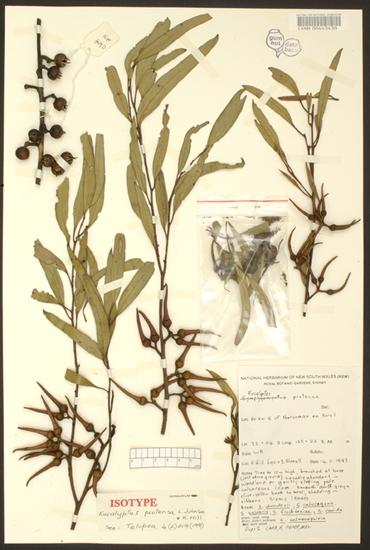Eucalyptus | Symphyomyrtus | Bisectae | Glandulosae | Erectae | Annulatae
Euclid - Online edition
Eucalyptus protensa
Bark smooth, of 'oily' appearance, dark grey to light brownish grey over yellowish green or bronze.
Pith glands present in branchlets; three-year old branchlets may become glaucous.
Juvenile growth (coppice or field seedlings to 50 cm): not seen.
Adult leaves held more or less erect, alternate, petiole 1–2 cm long; blade narrowly lanceolate, (4.3)5–12.5 cm long, 0.7–1.7 cm wide, base tapering to petiole, margins entire, apex pointed, concolorous, glossy, dark green, side-veins acute or obscure, reticulation obscured by numerous round oil glands, intramarginal vein close to edge or obscure.
Inflorescence axillary, single, peduncles rounded to only narrowly flattened, scarcely broadened apically, erect or rigidly down-turned, 0.7–1.3 cm long, buds 7, conspicuously pedicellate (pedicels 0.3–0.7 cm long). Mature buds 2.9–4 cm long, 0.6–0.9 cm wide, scar present (outer operculum shed early), operculum very elongated, finely tapering and often curved, to 7 times the length of the globular hypanthium and narrower than it at the join, stamens erect, anthers narrowly oblong, versatile, sub-basifixed with the filament tapering abruptly, dehiscing by longitudinal slits, style straight, just shorter than the longest stamens, stigma tapering to blunt, locules (3)4, the placentae convex, each with 4 to 6 vertical ovule rows or the rows indistinct. Flowers yellow-green.
Fruit erect or down-turned, pedicellate (pedicels 0.1–0.6 cm long), hemispherical or truncate-globose, 0.6–0.8 cm long, 0.8–1.3 cm wide, disc narrow, descending obliquely to vertically, valves (3)4, strongly exserted.
Seeds brown to straw-coloured, 1.8–3 mm long, cuboid to ovoid, dorsal surface narrowly and irregularly fissured, sides angled, margin irregular, hilum terminal or ventral. (Seedcoat often referred to as being honey-combed.)
Cultivated seedlings (measured at ca node 10): cotyledons Y-shaped (bisected); stems square in cross-section, smooth; leaves always petiolate, opposite for 5 to 7 nodes then alternate, ovate, 2.5–4 cm long, 1–3.3 cm wide, base truncate to tapering, green to grey-green, dull.
Flowering has been recorded in September, October and November.
A small low-branching smooth-barked mallet endemic to Western Australia. It occurs from just south of Norseman east towards Balladonia in the Fraser Range area, on calcareous red loams.
Eucalyptus protensa belongs in Eucalyptus subgenus Symphyomyrtus section Bisectae subsection Glandulosae because the buds have two opercula, the cotyledons are bisected and the branchlets have numerous oil glands in the pith. Within subsection Glandulosae, the 3 species E. extensa, E. protensa and E. annulata form series Erectae subseries Annulatae having smooth bark, buds with long operculum, erect stamens, adult leaves with numerous oil glands obscuring the sideveins and reticulation, and seed with fissured seed coat.
Eucalyptus protensa is most closely related to E. annulata from the southern sub-coastal and southern wheatbelt areas, and to E. extensa which is found in the area between Salmon Gums, Hyden and Southern Cross. E. protensa is easily distinguished from both these species by having slender scarcely flattened peduncles, conspicuously pedicellate buds, and opercula that taper finely, are often curved and are much longer than the hypanthium. E. extensa has only shortly pedicellate buds that are stouter than those of E. protensa. Both E. extensa and E. annulata have broadly flattened peduncles. E. protensa and E. extensa are mallets whereas E. annulata seems to be predominantly mallee in habit.
It is related to the gimlets (series Contortae) by habit, bark type, seedcoat and the prominently exserted valves of the fruit but shares some bud and leaf characters with E. eremophila and related species (subseries Annulatae), viz. erect stamens and leaves with crowded round oil glands that completely obscure the venation.

















